Leadership and Management: Classical Theories in Service Industries
VerifiedAdded on 2020/10/22
|11
|3036
|284
Report
AI Summary
This report provides a comprehensive analysis of leadership and management within the service industry, focusing on the context of the Hazev, Haz and Tas restaurant chain. It begins by explaining various classical management theories, such as Frederick Taylor's scientific management and Henri Fayol's administrative principles, and their practical application in a service industry setting. The report also delves into the roles of leaders and different leadership styles, including autocratic, democratic, laissez-faire, and consultative approaches, assessing their effectiveness within the chosen organization. Furthermore, it examines the internal and external factors that influence management styles, such as human resources, organizational structure, customer demands, and technological advancements. The report concludes by summarizing the key findings and emphasizing the crucial role of effective leadership and management in achieving organizational goals within the service sector.
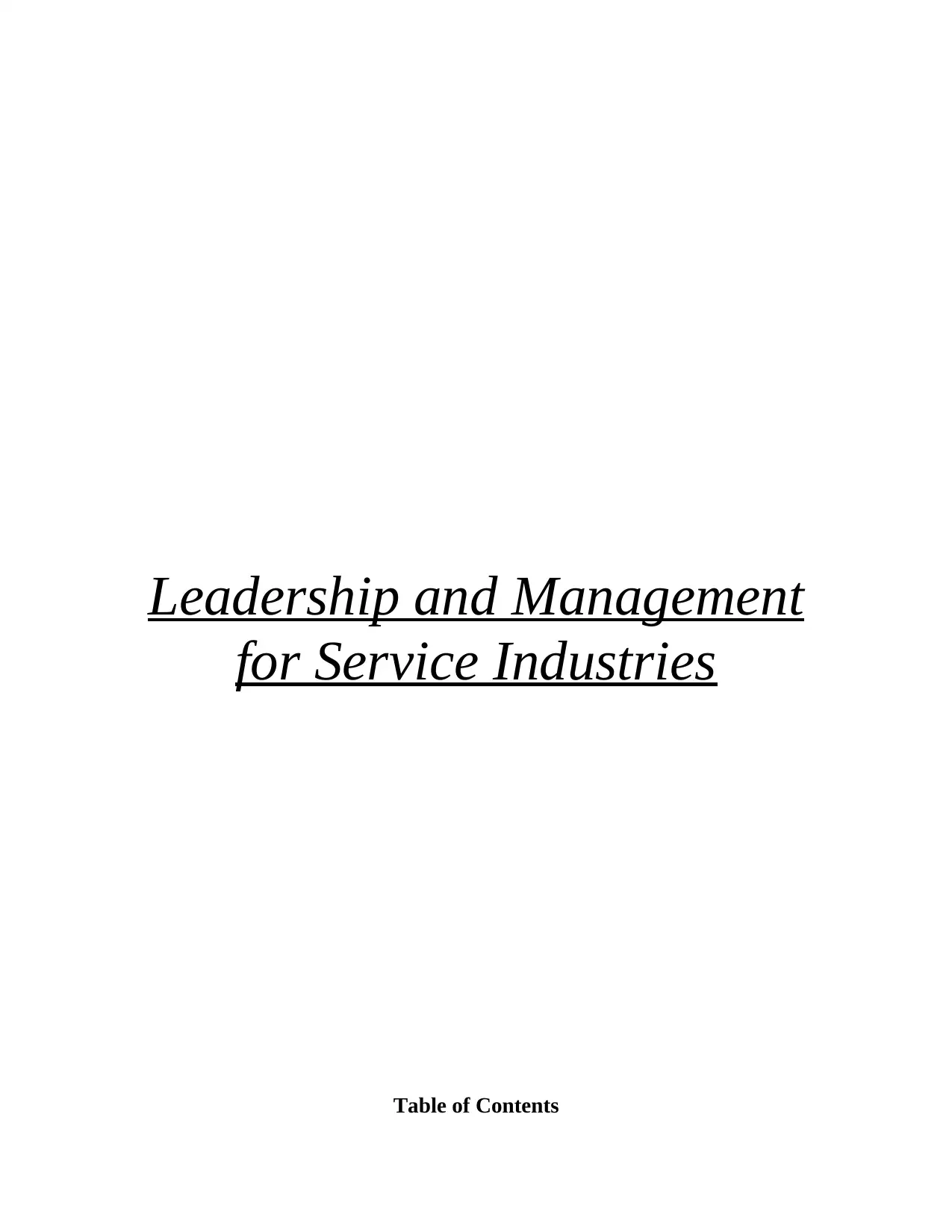
Leadership and Management
for Service Industries
Table of Contents
for Service Industries
Table of Contents
Paraphrase This Document
Need a fresh take? Get an instant paraphrase of this document with our AI Paraphraser
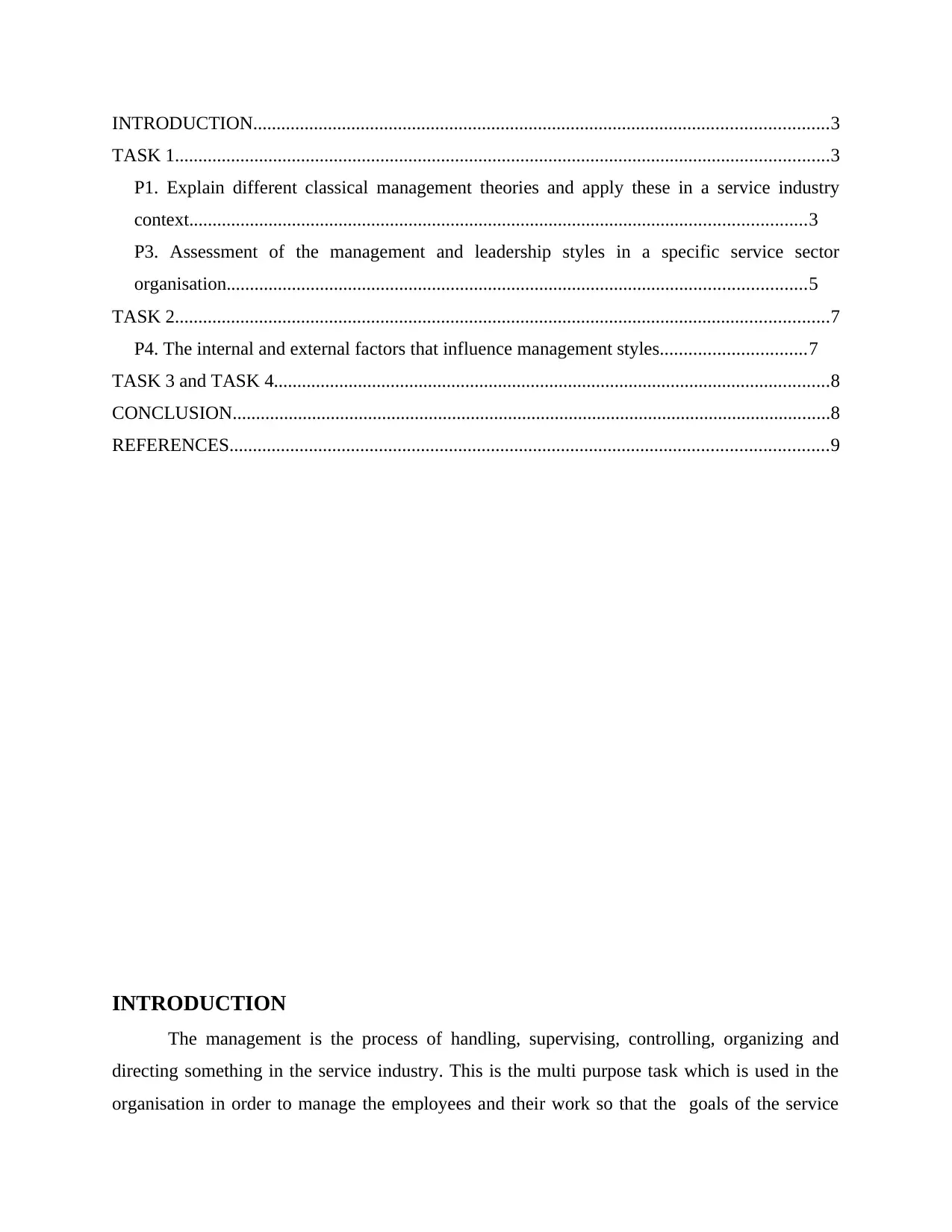
INTRODUCTION...........................................................................................................................3
TASK 1............................................................................................................................................3
P1. Explain different classical management theories and apply these in a service industry
context....................................................................................................................................3
P3. Assessment of the management and leadership styles in a specific service sector
organisation............................................................................................................................5
TASK 2............................................................................................................................................7
P4. The internal and external factors that influence management styles...............................7
TASK 3 and TASK 4.......................................................................................................................8
CONCLUSION................................................................................................................................8
REFERENCES................................................................................................................................9
INTRODUCTION
The management is the process of handling, supervising, controlling, organizing and
directing something in the service industry. This is the multi purpose task which is used in the
organisation in order to manage the employees and their work so that the goals of the service
TASK 1............................................................................................................................................3
P1. Explain different classical management theories and apply these in a service industry
context....................................................................................................................................3
P3. Assessment of the management and leadership styles in a specific service sector
organisation............................................................................................................................5
TASK 2............................................................................................................................................7
P4. The internal and external factors that influence management styles...............................7
TASK 3 and TASK 4.......................................................................................................................8
CONCLUSION................................................................................................................................8
REFERENCES................................................................................................................................9
INTRODUCTION
The management is the process of handling, supervising, controlling, organizing and
directing something in the service industry. This is the multi purpose task which is used in the
organisation in order to manage the employees and their work so that the goals of the service
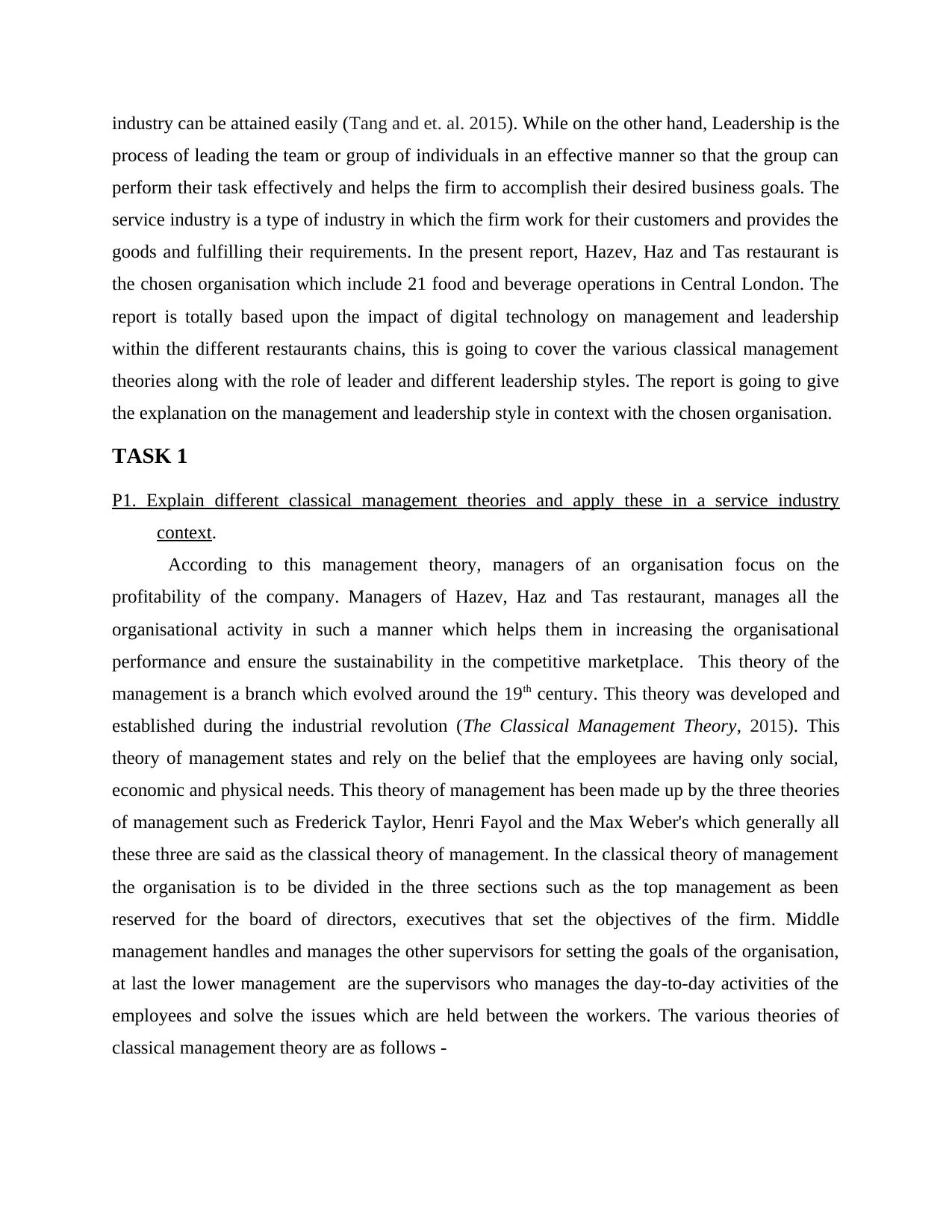
industry can be attained easily (Tang and et. al. 2015). While on the other hand, Leadership is the
process of leading the team or group of individuals in an effective manner so that the group can
perform their task effectively and helps the firm to accomplish their desired business goals. The
service industry is a type of industry in which the firm work for their customers and provides the
goods and fulfilling their requirements. In the present report, Hazev, Haz and Tas restaurant is
the chosen organisation which include 21 food and beverage operations in Central London. The
report is totally based upon the impact of digital technology on management and leadership
within the different restaurants chains, this is going to cover the various classical management
theories along with the role of leader and different leadership styles. The report is going to give
the explanation on the management and leadership style in context with the chosen organisation.
TASK 1
P1. Explain different classical management theories and apply these in a service industry
context.
According to this management theory, managers of an organisation focus on the
profitability of the company. Managers of Hazev, Haz and Tas restaurant, manages all the
organisational activity in such a manner which helps them in increasing the organisational
performance and ensure the sustainability in the competitive marketplace. This theory of the
management is a branch which evolved around the 19th century. This theory was developed and
established during the industrial revolution (The Classical Management Theory, 2015). This
theory of management states and rely on the belief that the employees are having only social,
economic and physical needs. This theory of management has been made up by the three theories
of management such as Frederick Taylor, Henri Fayol and the Max Weber's which generally all
these three are said as the classical theory of management. In the classical theory of management
the organisation is to be divided in the three sections such as the top management as been
reserved for the board of directors, executives that set the objectives of the firm. Middle
management handles and manages the other supervisors for setting the goals of the organisation,
at last the lower management are the supervisors who manages the day-to-day activities of the
employees and solve the issues which are held between the workers. The various theories of
classical management theory are as follows -
process of leading the team or group of individuals in an effective manner so that the group can
perform their task effectively and helps the firm to accomplish their desired business goals. The
service industry is a type of industry in which the firm work for their customers and provides the
goods and fulfilling their requirements. In the present report, Hazev, Haz and Tas restaurant is
the chosen organisation which include 21 food and beverage operations in Central London. The
report is totally based upon the impact of digital technology on management and leadership
within the different restaurants chains, this is going to cover the various classical management
theories along with the role of leader and different leadership styles. The report is going to give
the explanation on the management and leadership style in context with the chosen organisation.
TASK 1
P1. Explain different classical management theories and apply these in a service industry
context.
According to this management theory, managers of an organisation focus on the
profitability of the company. Managers of Hazev, Haz and Tas restaurant, manages all the
organisational activity in such a manner which helps them in increasing the organisational
performance and ensure the sustainability in the competitive marketplace. This theory of the
management is a branch which evolved around the 19th century. This theory was developed and
established during the industrial revolution (The Classical Management Theory, 2015). This
theory of management states and rely on the belief that the employees are having only social,
economic and physical needs. This theory of management has been made up by the three theories
of management such as Frederick Taylor, Henri Fayol and the Max Weber's which generally all
these three are said as the classical theory of management. In the classical theory of management
the organisation is to be divided in the three sections such as the top management as been
reserved for the board of directors, executives that set the objectives of the firm. Middle
management handles and manages the other supervisors for setting the goals of the organisation,
at last the lower management are the supervisors who manages the day-to-day activities of the
employees and solve the issues which are held between the workers. The various theories of
classical management theory are as follows -
⊘ This is a preview!⊘
Do you want full access?
Subscribe today to unlock all pages.

Trusted by 1+ million students worldwide
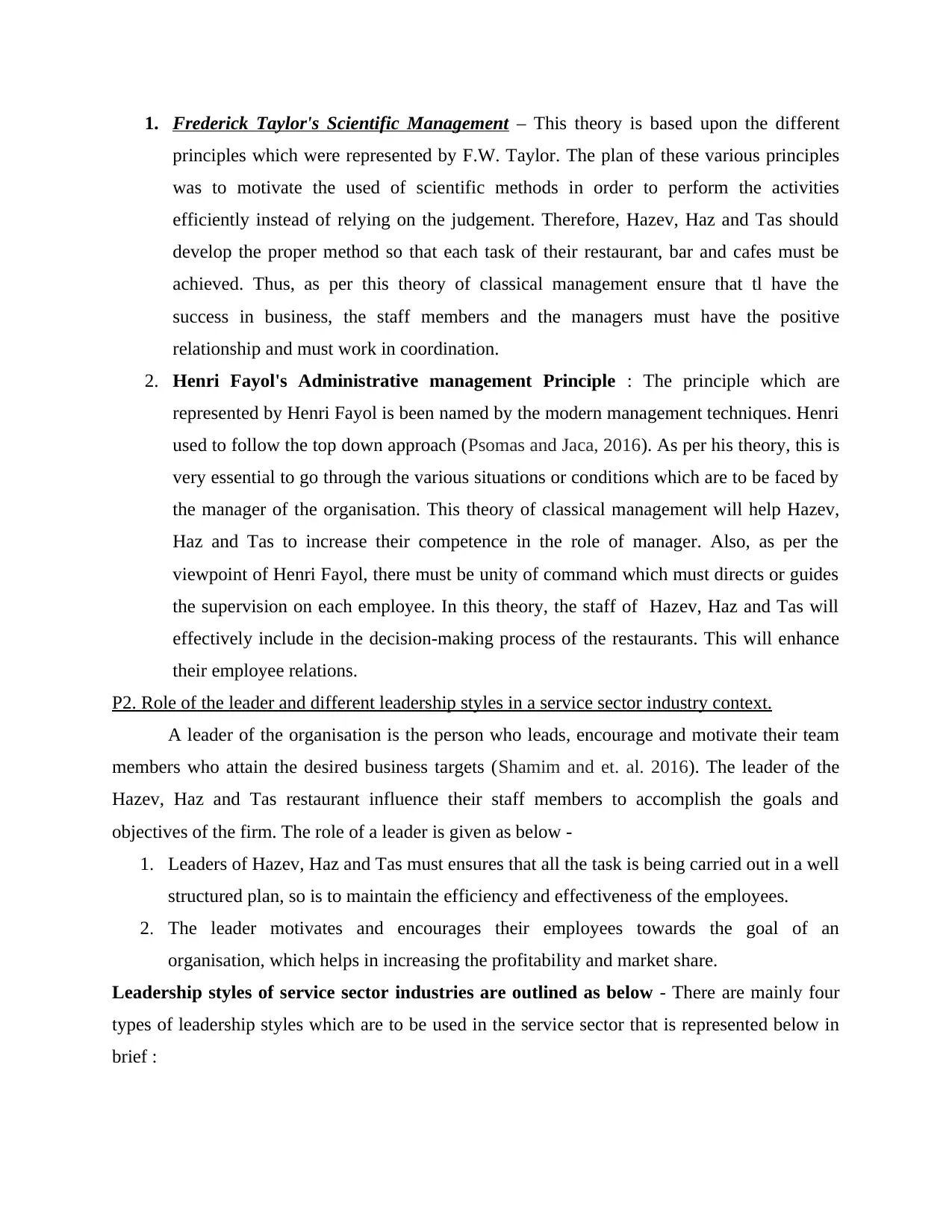
1. Frederick Taylor's Scientific Management – This theory is based upon the different
principles which were represented by F.W. Taylor. The plan of these various principles
was to motivate the used of scientific methods in order to perform the activities
efficiently instead of relying on the judgement. Therefore, Hazev, Haz and Tas should
develop the proper method so that each task of their restaurant, bar and cafes must be
achieved. Thus, as per this theory of classical management ensure that tl have the
success in business, the staff members and the managers must have the positive
relationship and must work in coordination.
2. Henri Fayol's Administrative management Principle : The principle which are
represented by Henri Fayol is been named by the modern management techniques. Henri
used to follow the top down approach (Psomas and Jaca, 2016). As per his theory, this is
very essential to go through the various situations or conditions which are to be faced by
the manager of the organisation. This theory of classical management will help Hazev,
Haz and Tas to increase their competence in the role of manager. Also, as per the
viewpoint of Henri Fayol, there must be unity of command which must directs or guides
the supervision on each employee. In this theory, the staff of Hazev, Haz and Tas will
effectively include in the decision-making process of the restaurants. This will enhance
their employee relations.
P2. Role of the leader and different leadership styles in a service sector industry context.
A leader of the organisation is the person who leads, encourage and motivate their team
members who attain the desired business targets (Shamim and et. al. 2016). The leader of the
Hazev, Haz and Tas restaurant influence their staff members to accomplish the goals and
objectives of the firm. The role of a leader is given as below -
1. Leaders of Hazev, Haz and Tas must ensures that all the task is being carried out in a well
structured plan, so is to maintain the efficiency and effectiveness of the employees.
2. The leader motivates and encourages their employees towards the goal of an
organisation, which helps in increasing the profitability and market share.
Leadership styles of service sector industries are outlined as below - There are mainly four
types of leadership styles which are to be used in the service sector that is represented below in
brief :
principles which were represented by F.W. Taylor. The plan of these various principles
was to motivate the used of scientific methods in order to perform the activities
efficiently instead of relying on the judgement. Therefore, Hazev, Haz and Tas should
develop the proper method so that each task of their restaurant, bar and cafes must be
achieved. Thus, as per this theory of classical management ensure that tl have the
success in business, the staff members and the managers must have the positive
relationship and must work in coordination.
2. Henri Fayol's Administrative management Principle : The principle which are
represented by Henri Fayol is been named by the modern management techniques. Henri
used to follow the top down approach (Psomas and Jaca, 2016). As per his theory, this is
very essential to go through the various situations or conditions which are to be faced by
the manager of the organisation. This theory of classical management will help Hazev,
Haz and Tas to increase their competence in the role of manager. Also, as per the
viewpoint of Henri Fayol, there must be unity of command which must directs or guides
the supervision on each employee. In this theory, the staff of Hazev, Haz and Tas will
effectively include in the decision-making process of the restaurants. This will enhance
their employee relations.
P2. Role of the leader and different leadership styles in a service sector industry context.
A leader of the organisation is the person who leads, encourage and motivate their team
members who attain the desired business targets (Shamim and et. al. 2016). The leader of the
Hazev, Haz and Tas restaurant influence their staff members to accomplish the goals and
objectives of the firm. The role of a leader is given as below -
1. Leaders of Hazev, Haz and Tas must ensures that all the task is being carried out in a well
structured plan, so is to maintain the efficiency and effectiveness of the employees.
2. The leader motivates and encourages their employees towards the goal of an
organisation, which helps in increasing the profitability and market share.
Leadership styles of service sector industries are outlined as below - There are mainly four
types of leadership styles which are to be used in the service sector that is represented below in
brief :
Paraphrase This Document
Need a fresh take? Get an instant paraphrase of this document with our AI Paraphraser
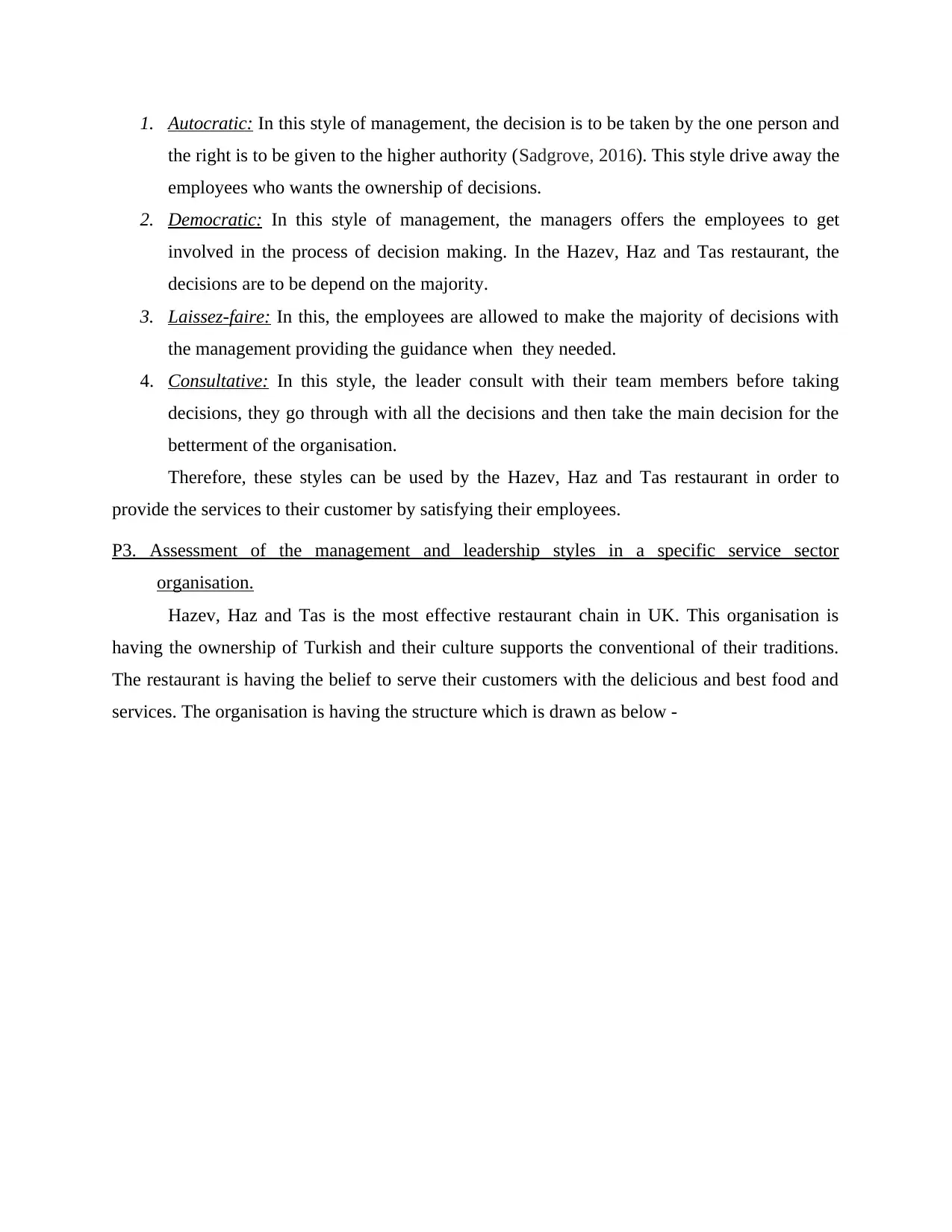
1. Autocratic: In this style of management, the decision is to be taken by the one person and
the right is to be given to the higher authority (Sadgrove, 2016). This style drive away the
employees who wants the ownership of decisions.
2. Democratic: In this style of management, the managers offers the employees to get
involved in the process of decision making. In the Hazev, Haz and Tas restaurant, the
decisions are to be depend on the majority.
3. Laissez-faire: In this, the employees are allowed to make the majority of decisions with
the management providing the guidance when they needed.
4. Consultative: In this style, the leader consult with their team members before taking
decisions, they go through with all the decisions and then take the main decision for the
betterment of the organisation.
Therefore, these styles can be used by the Hazev, Haz and Tas restaurant in order to
provide the services to their customer by satisfying their employees.
P3. Assessment of the management and leadership styles in a specific service sector
organisation.
Hazev, Haz and Tas is the most effective restaurant chain in UK. This organisation is
having the ownership of Turkish and their culture supports the conventional of their traditions.
The restaurant is having the belief to serve their customers with the delicious and best food and
services. The organisation is having the structure which is drawn as below -
the right is to be given to the higher authority (Sadgrove, 2016). This style drive away the
employees who wants the ownership of decisions.
2. Democratic: In this style of management, the managers offers the employees to get
involved in the process of decision making. In the Hazev, Haz and Tas restaurant, the
decisions are to be depend on the majority.
3. Laissez-faire: In this, the employees are allowed to make the majority of decisions with
the management providing the guidance when they needed.
4. Consultative: In this style, the leader consult with their team members before taking
decisions, they go through with all the decisions and then take the main decision for the
betterment of the organisation.
Therefore, these styles can be used by the Hazev, Haz and Tas restaurant in order to
provide the services to their customer by satisfying their employees.
P3. Assessment of the management and leadership styles in a specific service sector
organisation.
Hazev, Haz and Tas is the most effective restaurant chain in UK. This organisation is
having the ownership of Turkish and their culture supports the conventional of their traditions.
The restaurant is having the belief to serve their customers with the delicious and best food and
services. The organisation is having the structure which is drawn as below -
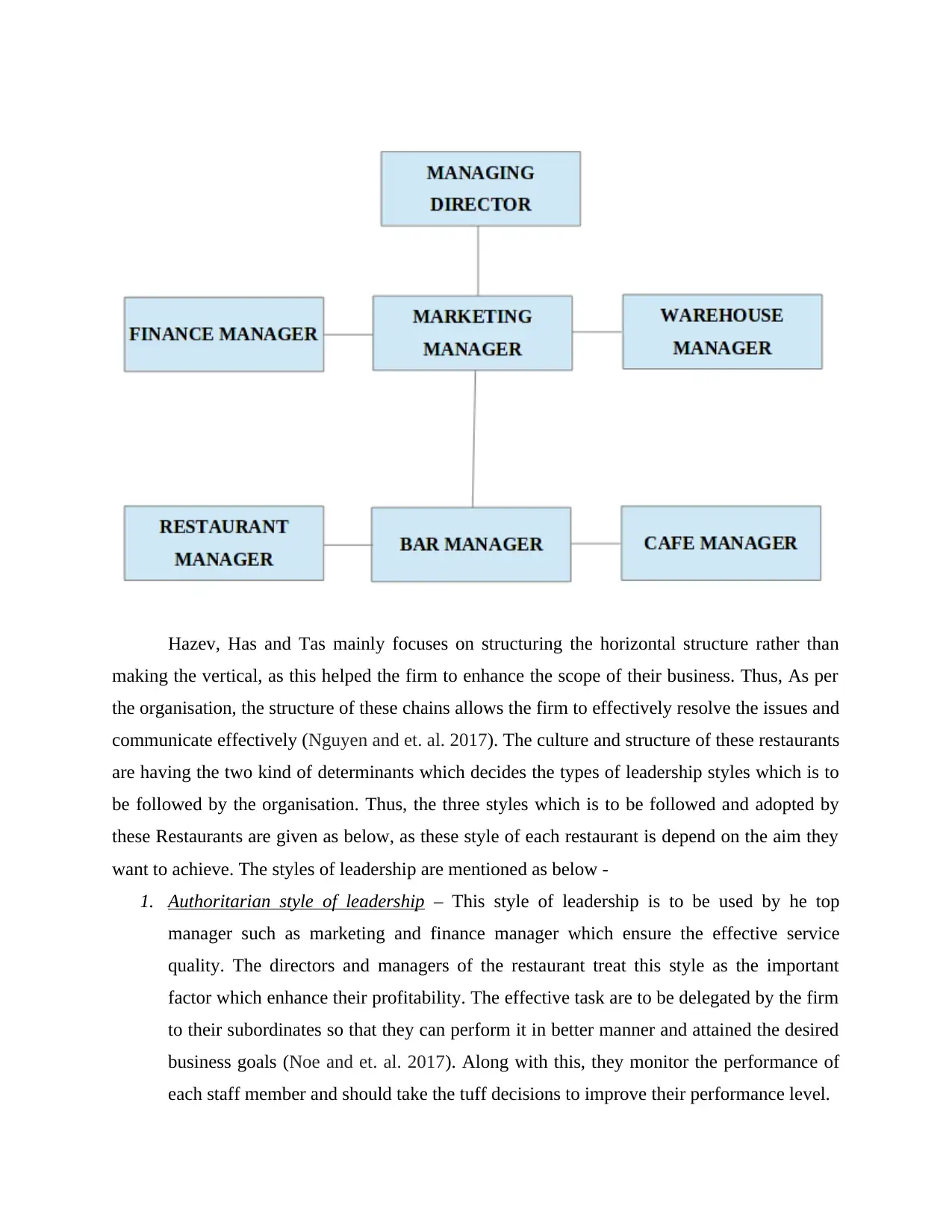
Hazev, Has and Tas mainly focuses on structuring the horizontal structure rather than
making the vertical, as this helped the firm to enhance the scope of their business. Thus, As per
the organisation, the structure of these chains allows the firm to effectively resolve the issues and
communicate effectively (Nguyen and et. al. 2017). The culture and structure of these restaurants
are having the two kind of determinants which decides the types of leadership styles which is to
be followed by the organisation. Thus, the three styles which is to be followed and adopted by
these Restaurants are given as below, as these style of each restaurant is depend on the aim they
want to achieve. The styles of leadership are mentioned as below -
1. Authoritarian style of leadership – This style of leadership is to be used by he top
manager such as marketing and finance manager which ensure the effective service
quality. The directors and managers of the restaurant treat this style as the important
factor which enhance their profitability. The effective task are to be delegated by the firm
to their subordinates so that they can perform it in better manner and attained the desired
business goals (Noe and et. al. 2017). Along with this, they monitor the performance of
each staff member and should take the tuff decisions to improve their performance level.
making the vertical, as this helped the firm to enhance the scope of their business. Thus, As per
the organisation, the structure of these chains allows the firm to effectively resolve the issues and
communicate effectively (Nguyen and et. al. 2017). The culture and structure of these restaurants
are having the two kind of determinants which decides the types of leadership styles which is to
be followed by the organisation. Thus, the three styles which is to be followed and adopted by
these Restaurants are given as below, as these style of each restaurant is depend on the aim they
want to achieve. The styles of leadership are mentioned as below -
1. Authoritarian style of leadership – This style of leadership is to be used by he top
manager such as marketing and finance manager which ensure the effective service
quality. The directors and managers of the restaurant treat this style as the important
factor which enhance their profitability. The effective task are to be delegated by the firm
to their subordinates so that they can perform it in better manner and attained the desired
business goals (Noe and et. al. 2017). Along with this, they monitor the performance of
each staff member and should take the tuff decisions to improve their performance level.
⊘ This is a preview!⊘
Do you want full access?
Subscribe today to unlock all pages.

Trusted by 1+ million students worldwide
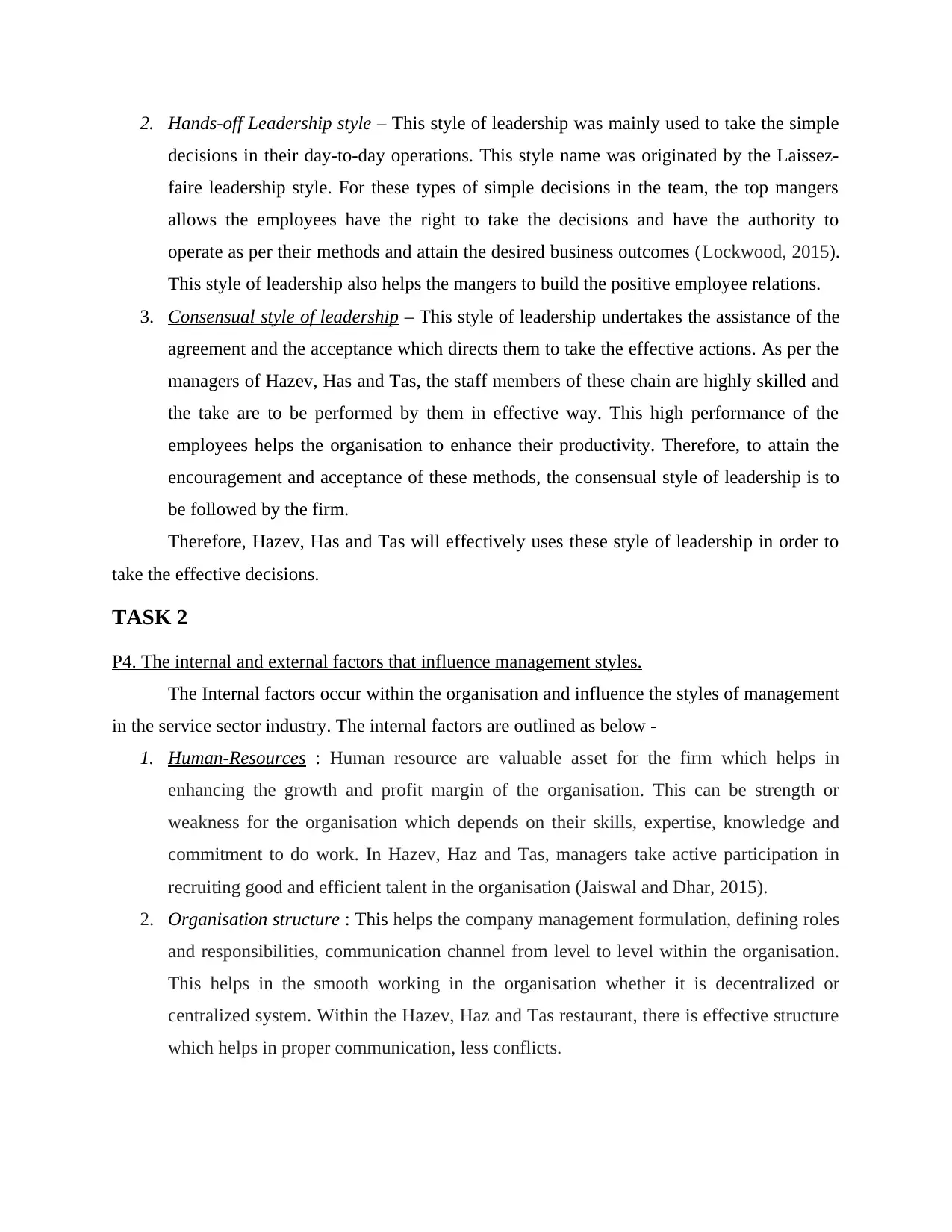
2. Hands-off Leadership style – This style of leadership was mainly used to take the simple
decisions in their day-to-day operations. This style name was originated by the Laissez-
faire leadership style. For these types of simple decisions in the team, the top mangers
allows the employees have the right to take the decisions and have the authority to
operate as per their methods and attain the desired business outcomes (Lockwood, 2015).
This style of leadership also helps the mangers to build the positive employee relations.
3. Consensual style of leadership – This style of leadership undertakes the assistance of the
agreement and the acceptance which directs them to take the effective actions. As per the
managers of Hazev, Has and Tas, the staff members of these chain are highly skilled and
the take are to be performed by them in effective way. This high performance of the
employees helps the organisation to enhance their productivity. Therefore, to attain the
encouragement and acceptance of these methods, the consensual style of leadership is to
be followed by the firm.
Therefore, Hazev, Has and Tas will effectively uses these style of leadership in order to
take the effective decisions.
TASK 2
P4. The internal and external factors that influence management styles.
The Internal factors occur within the organisation and influence the styles of management
in the service sector industry. The internal factors are outlined as below -
1. Human-Resources : Human resource are valuable asset for the firm which helps in
enhancing the growth and profit margin of the organisation. This can be strength or
weakness for the organisation which depends on their skills, expertise, knowledge and
commitment to do work. In Hazev, Haz and Tas, managers take active participation in
recruiting good and efficient talent in the organisation (Jaiswal and Dhar, 2015).
2. Organisation structure : This helps the company management formulation, defining roles
and responsibilities, communication channel from level to level within the organisation.
This helps in the smooth working in the organisation whether it is decentralized or
centralized system. Within the Hazev, Haz and Tas restaurant, there is effective structure
which helps in proper communication, less conflicts.
decisions in their day-to-day operations. This style name was originated by the Laissez-
faire leadership style. For these types of simple decisions in the team, the top mangers
allows the employees have the right to take the decisions and have the authority to
operate as per their methods and attain the desired business outcomes (Lockwood, 2015).
This style of leadership also helps the mangers to build the positive employee relations.
3. Consensual style of leadership – This style of leadership undertakes the assistance of the
agreement and the acceptance which directs them to take the effective actions. As per the
managers of Hazev, Has and Tas, the staff members of these chain are highly skilled and
the take are to be performed by them in effective way. This high performance of the
employees helps the organisation to enhance their productivity. Therefore, to attain the
encouragement and acceptance of these methods, the consensual style of leadership is to
be followed by the firm.
Therefore, Hazev, Has and Tas will effectively uses these style of leadership in order to
take the effective decisions.
TASK 2
P4. The internal and external factors that influence management styles.
The Internal factors occur within the organisation and influence the styles of management
in the service sector industry. The internal factors are outlined as below -
1. Human-Resources : Human resource are valuable asset for the firm which helps in
enhancing the growth and profit margin of the organisation. This can be strength or
weakness for the organisation which depends on their skills, expertise, knowledge and
commitment to do work. In Hazev, Haz and Tas, managers take active participation in
recruiting good and efficient talent in the organisation (Jaiswal and Dhar, 2015).
2. Organisation structure : This helps the company management formulation, defining roles
and responsibilities, communication channel from level to level within the organisation.
This helps in the smooth working in the organisation whether it is decentralized or
centralized system. Within the Hazev, Haz and Tas restaurant, there is effective structure
which helps in proper communication, less conflicts.
Paraphrase This Document
Need a fresh take? Get an instant paraphrase of this document with our AI Paraphraser
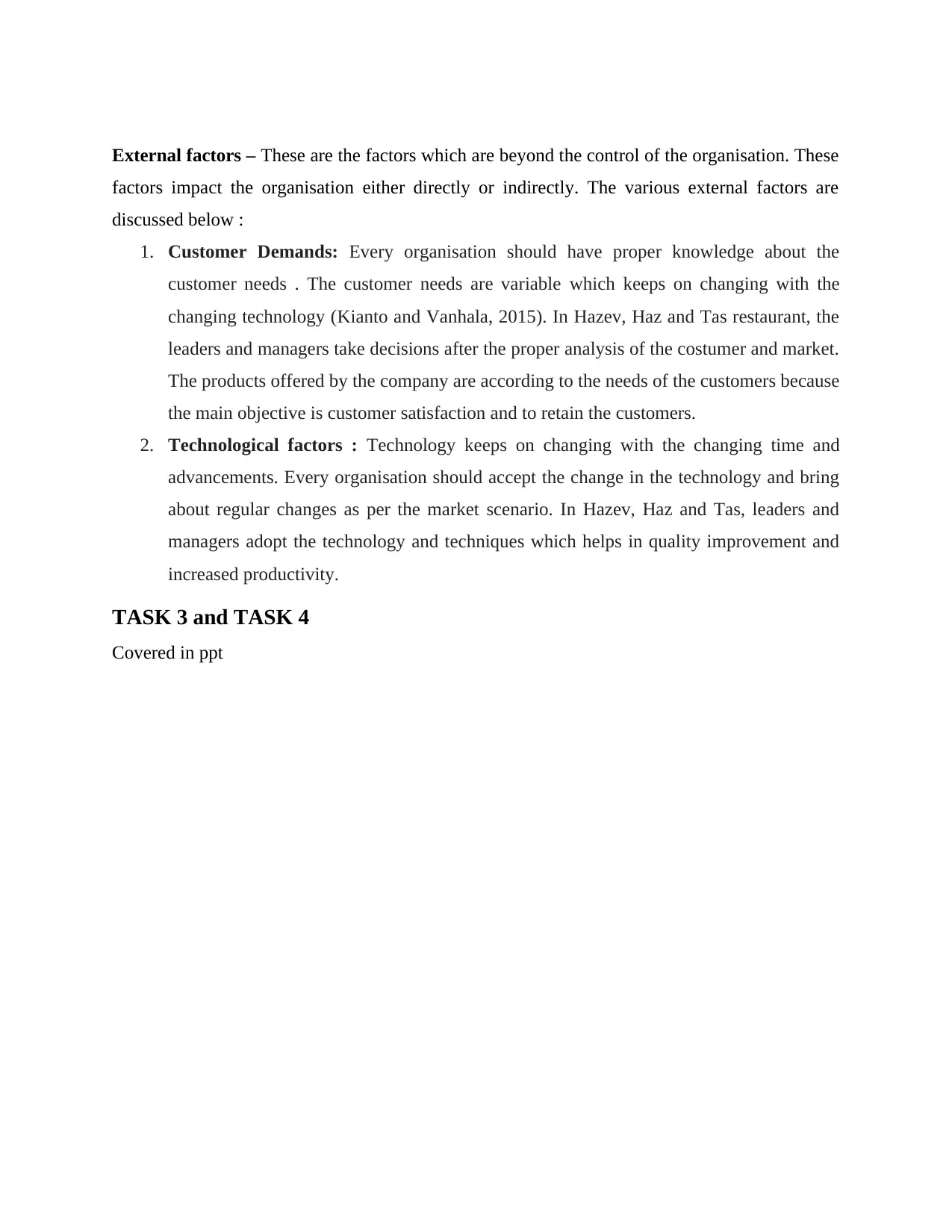
External factors – These are the factors which are beyond the control of the organisation. These
factors impact the organisation either directly or indirectly. The various external factors are
discussed below :
1. Customer Demands: Every organisation should have proper knowledge about the
customer needs . The customer needs are variable which keeps on changing with the
changing technology (Kianto and Vanhala, 2015). In Hazev, Haz and Tas restaurant, the
leaders and managers take decisions after the proper analysis of the costumer and market.
The products offered by the company are according to the needs of the customers because
the main objective is customer satisfaction and to retain the customers.
2. Technological factors : Technology keeps on changing with the changing time and
advancements. Every organisation should accept the change in the technology and bring
about regular changes as per the market scenario. In Hazev, Haz and Tas, leaders and
managers adopt the technology and techniques which helps in quality improvement and
increased productivity.
TASK 3 and TASK 4
Covered in ppt
factors impact the organisation either directly or indirectly. The various external factors are
discussed below :
1. Customer Demands: Every organisation should have proper knowledge about the
customer needs . The customer needs are variable which keeps on changing with the
changing technology (Kianto and Vanhala, 2015). In Hazev, Haz and Tas restaurant, the
leaders and managers take decisions after the proper analysis of the costumer and market.
The products offered by the company are according to the needs of the customers because
the main objective is customer satisfaction and to retain the customers.
2. Technological factors : Technology keeps on changing with the changing time and
advancements. Every organisation should accept the change in the technology and bring
about regular changes as per the market scenario. In Hazev, Haz and Tas, leaders and
managers adopt the technology and techniques which helps in quality improvement and
increased productivity.
TASK 3 and TASK 4
Covered in ppt
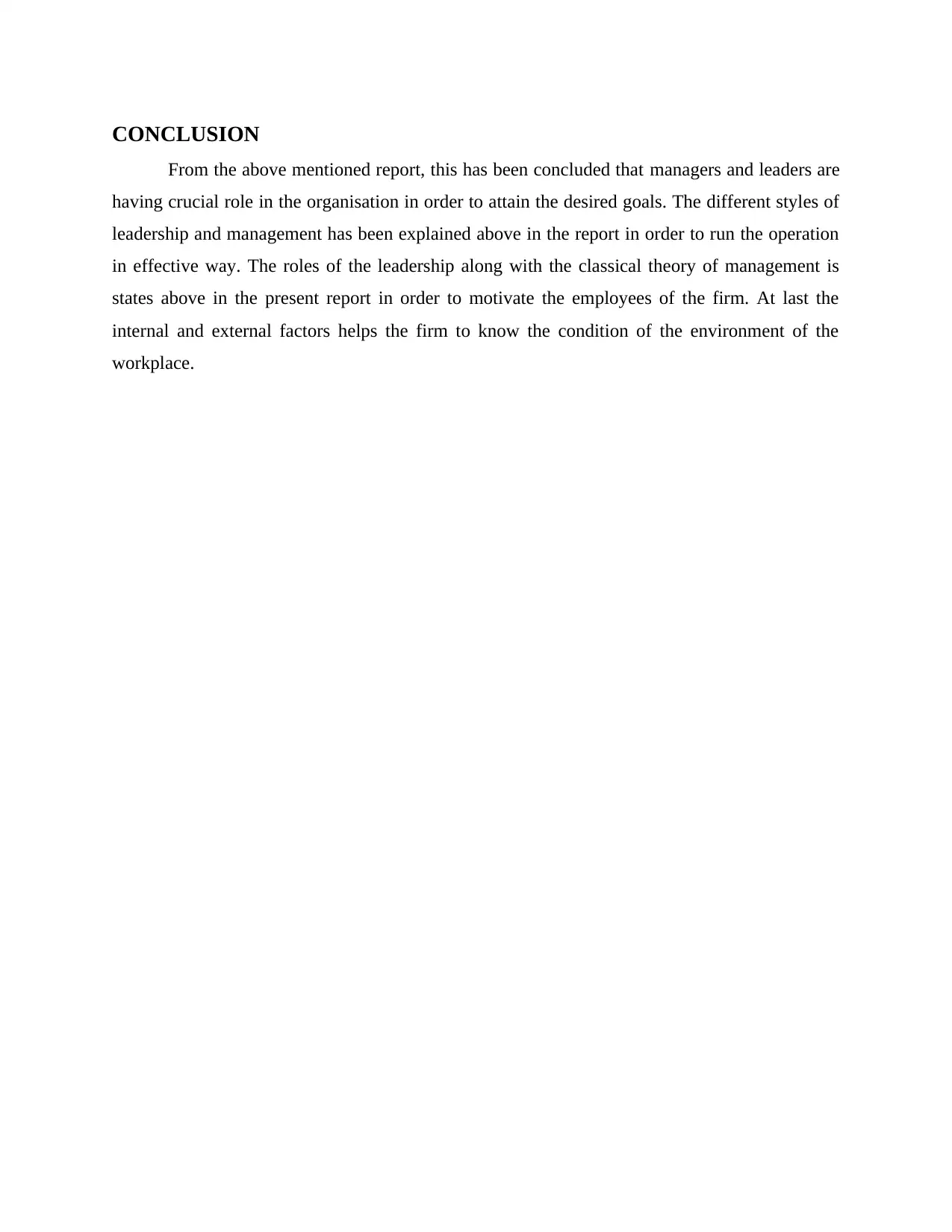
CONCLUSION
From the above mentioned report, this has been concluded that managers and leaders are
having crucial role in the organisation in order to attain the desired goals. The different styles of
leadership and management has been explained above in the report in order to run the operation
in effective way. The roles of the leadership along with the classical theory of management is
states above in the present report in order to motivate the employees of the firm. At last the
internal and external factors helps the firm to know the condition of the environment of the
workplace.
From the above mentioned report, this has been concluded that managers and leaders are
having crucial role in the organisation in order to attain the desired goals. The different styles of
leadership and management has been explained above in the report in order to run the operation
in effective way. The roles of the leadership along with the classical theory of management is
states above in the present report in order to motivate the employees of the firm. At last the
internal and external factors helps the firm to know the condition of the environment of the
workplace.
⊘ This is a preview!⊘
Do you want full access?
Subscribe today to unlock all pages.

Trusted by 1+ million students worldwide
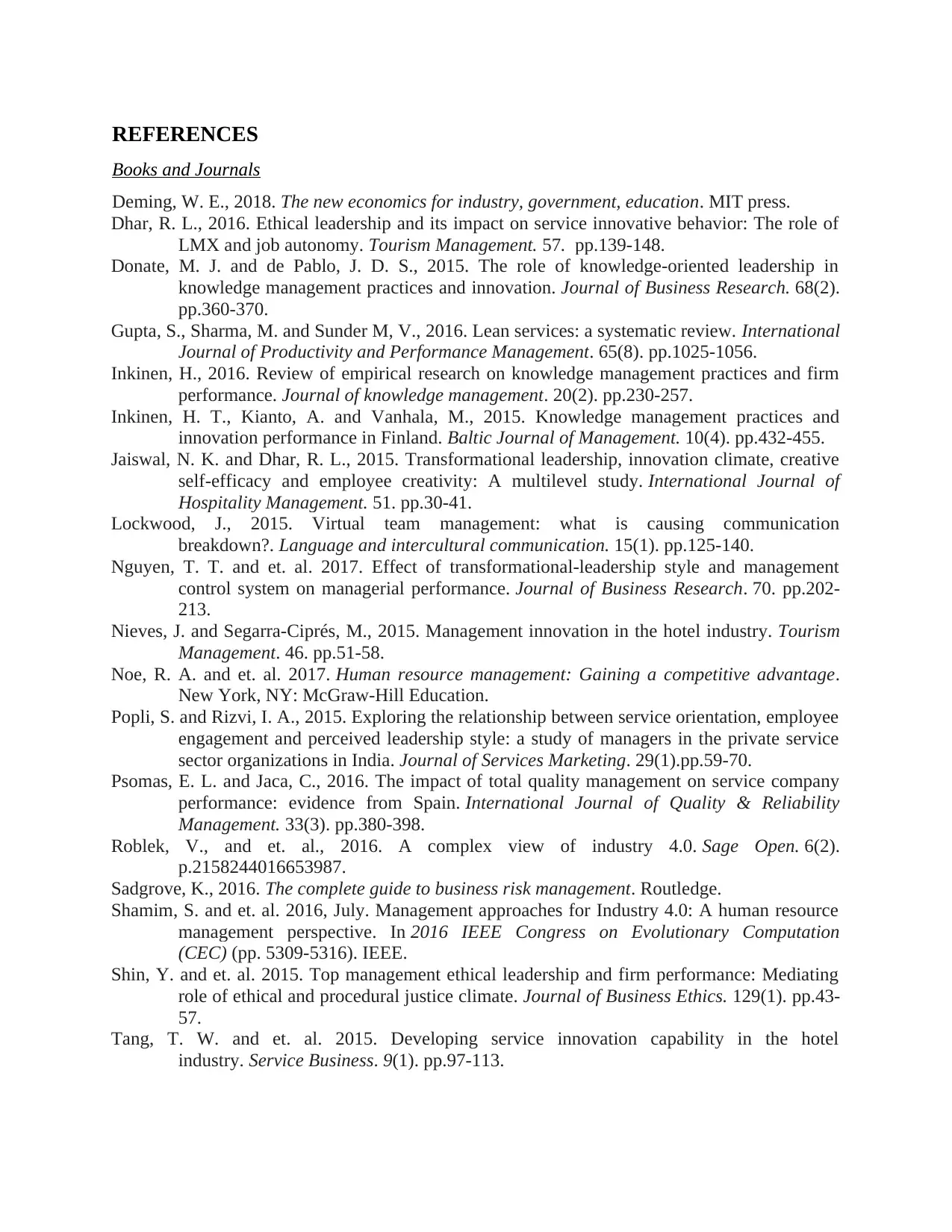
REFERENCES
Books and Journals
Deming, W. E., 2018. The new economics for industry, government, education. MIT press.
Dhar, R. L., 2016. Ethical leadership and its impact on service innovative behavior: The role of
LMX and job autonomy. Tourism Management. 57. pp.139-148.
Donate, M. J. and de Pablo, J. D. S., 2015. The role of knowledge-oriented leadership in
knowledge management practices and innovation. Journal of Business Research. 68(2).
pp.360-370.
Gupta, S., Sharma, M. and Sunder M, V., 2016. Lean services: a systematic review. International
Journal of Productivity and Performance Management. 65(8). pp.1025-1056.
Inkinen, H., 2016. Review of empirical research on knowledge management practices and firm
performance. Journal of knowledge management. 20(2). pp.230-257.
Inkinen, H. T., Kianto, A. and Vanhala, M., 2015. Knowledge management practices and
innovation performance in Finland. Baltic Journal of Management. 10(4). pp.432-455.
Jaiswal, N. K. and Dhar, R. L., 2015. Transformational leadership, innovation climate, creative
self-efficacy and employee creativity: A multilevel study. International Journal of
Hospitality Management. 51. pp.30-41.
Lockwood, J., 2015. Virtual team management: what is causing communication
breakdown?. Language and intercultural communication. 15(1). pp.125-140.
Nguyen, T. T. and et. al. 2017. Effect of transformational-leadership style and management
control system on managerial performance. Journal of Business Research. 70. pp.202-
213.
Nieves, J. and Segarra-Ciprés, M., 2015. Management innovation in the hotel industry. Tourism
Management. 46. pp.51-58.
Noe, R. A. and et. al. 2017. Human resource management: Gaining a competitive advantage.
New York, NY: McGraw-Hill Education.
Popli, S. and Rizvi, I. A., 2015. Exploring the relationship between service orientation, employee
engagement and perceived leadership style: a study of managers in the private service
sector organizations in India. Journal of Services Marketing. 29(1).pp.59-70.
Psomas, E. L. and Jaca, C., 2016. The impact of total quality management on service company
performance: evidence from Spain. International Journal of Quality & Reliability
Management. 33(3). pp.380-398.
Roblek, V., and et. al., 2016. A complex view of industry 4.0. Sage Open. 6(2).
p.2158244016653987.
Sadgrove, K., 2016. The complete guide to business risk management. Routledge.
Shamim, S. and et. al. 2016, July. Management approaches for Industry 4.0: A human resource
management perspective. In 2016 IEEE Congress on Evolutionary Computation
(CEC) (pp. 5309-5316). IEEE.
Shin, Y. and et. al. 2015. Top management ethical leadership and firm performance: Mediating
role of ethical and procedural justice climate. Journal of Business Ethics. 129(1). pp.43-
57.
Tang, T. W. and et. al. 2015. Developing service innovation capability in the hotel
industry. Service Business. 9(1). pp.97-113.
Books and Journals
Deming, W. E., 2018. The new economics for industry, government, education. MIT press.
Dhar, R. L., 2016. Ethical leadership and its impact on service innovative behavior: The role of
LMX and job autonomy. Tourism Management. 57. pp.139-148.
Donate, M. J. and de Pablo, J. D. S., 2015. The role of knowledge-oriented leadership in
knowledge management practices and innovation. Journal of Business Research. 68(2).
pp.360-370.
Gupta, S., Sharma, M. and Sunder M, V., 2016. Lean services: a systematic review. International
Journal of Productivity and Performance Management. 65(8). pp.1025-1056.
Inkinen, H., 2016. Review of empirical research on knowledge management practices and firm
performance. Journal of knowledge management. 20(2). pp.230-257.
Inkinen, H. T., Kianto, A. and Vanhala, M., 2015. Knowledge management practices and
innovation performance in Finland. Baltic Journal of Management. 10(4). pp.432-455.
Jaiswal, N. K. and Dhar, R. L., 2015. Transformational leadership, innovation climate, creative
self-efficacy and employee creativity: A multilevel study. International Journal of
Hospitality Management. 51. pp.30-41.
Lockwood, J., 2015. Virtual team management: what is causing communication
breakdown?. Language and intercultural communication. 15(1). pp.125-140.
Nguyen, T. T. and et. al. 2017. Effect of transformational-leadership style and management
control system on managerial performance. Journal of Business Research. 70. pp.202-
213.
Nieves, J. and Segarra-Ciprés, M., 2015. Management innovation in the hotel industry. Tourism
Management. 46. pp.51-58.
Noe, R. A. and et. al. 2017. Human resource management: Gaining a competitive advantage.
New York, NY: McGraw-Hill Education.
Popli, S. and Rizvi, I. A., 2015. Exploring the relationship between service orientation, employee
engagement and perceived leadership style: a study of managers in the private service
sector organizations in India. Journal of Services Marketing. 29(1).pp.59-70.
Psomas, E. L. and Jaca, C., 2016. The impact of total quality management on service company
performance: evidence from Spain. International Journal of Quality & Reliability
Management. 33(3). pp.380-398.
Roblek, V., and et. al., 2016. A complex view of industry 4.0. Sage Open. 6(2).
p.2158244016653987.
Sadgrove, K., 2016. The complete guide to business risk management. Routledge.
Shamim, S. and et. al. 2016, July. Management approaches for Industry 4.0: A human resource
management perspective. In 2016 IEEE Congress on Evolutionary Computation
(CEC) (pp. 5309-5316). IEEE.
Shin, Y. and et. al. 2015. Top management ethical leadership and firm performance: Mediating
role of ethical and procedural justice climate. Journal of Business Ethics. 129(1). pp.43-
57.
Tang, T. W. and et. al. 2015. Developing service innovation capability in the hotel
industry. Service Business. 9(1). pp.97-113.
Paraphrase This Document
Need a fresh take? Get an instant paraphrase of this document with our AI Paraphraser
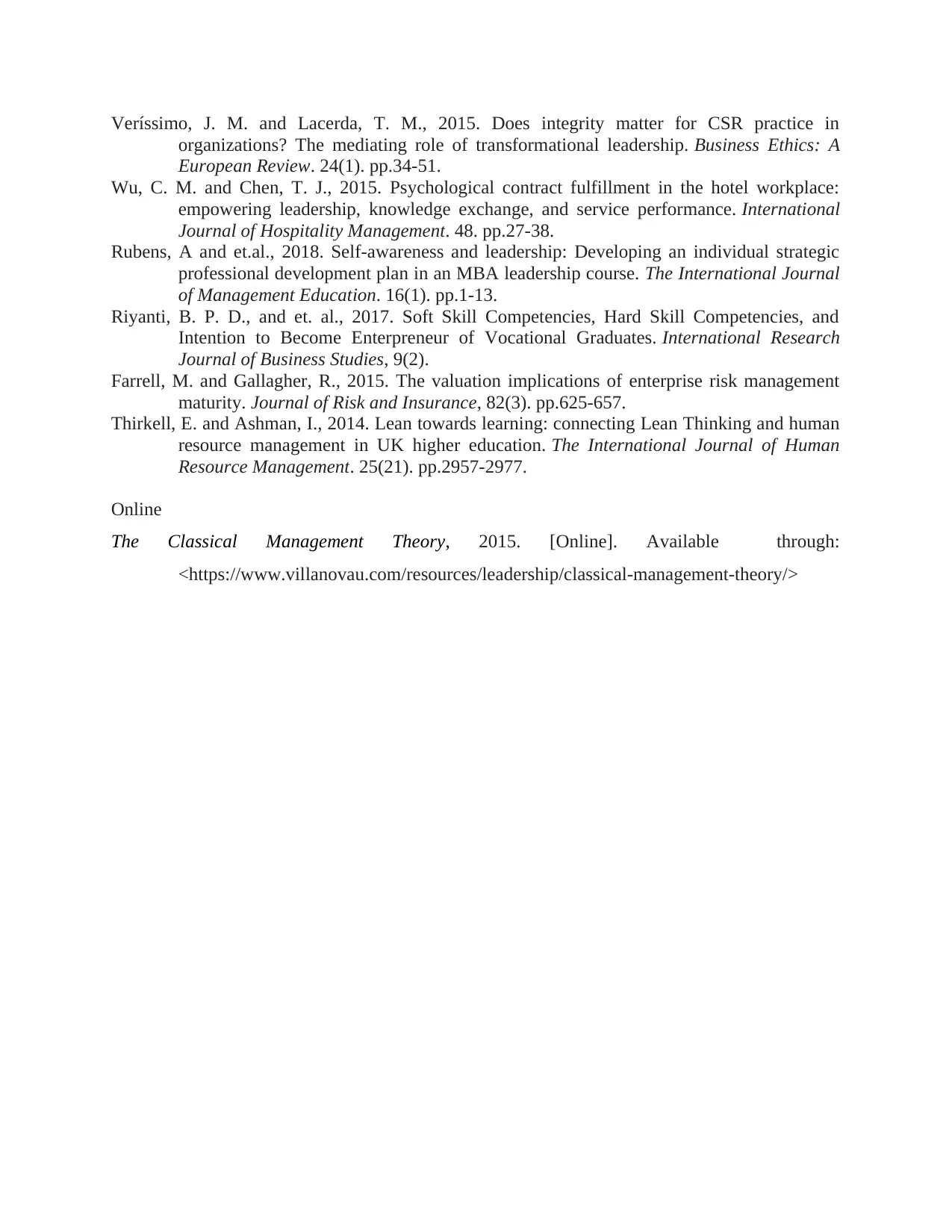
Veríssimo, J. M. and Lacerda, T. M., 2015. Does integrity matter for CSR practice in
organizations? The mediating role of transformational leadership. Business Ethics: A
European Review. 24(1). pp.34-51.
Wu, C. M. and Chen, T. J., 2015. Psychological contract fulfillment in the hotel workplace:
empowering leadership, knowledge exchange, and service performance. International
Journal of Hospitality Management. 48. pp.27-38.
Rubens, A and et.al., 2018. Self-awareness and leadership: Developing an individual strategic
professional development plan in an MBA leadership course. The International Journal
of Management Education. 16(1). pp.1-13.
Riyanti, B. P. D., and et. al., 2017. Soft Skill Competencies, Hard Skill Competencies, and
Intention to Become Enterpreneur of Vocational Graduates. International Research
Journal of Business Studies, 9(2).
Farrell, M. and Gallagher, R., 2015. The valuation implications of enterprise risk management
maturity. Journal of Risk and Insurance, 82(3). pp.625-657.
Thirkell, E. and Ashman, I., 2014. Lean towards learning: connecting Lean Thinking and human
resource management in UK higher education. The International Journal of Human
Resource Management. 25(21). pp.2957-2977.
Online
The Classical Management Theory, 2015. [Online]. Available through:
<https://www.villanovau.com/resources/leadership/classical-management-theory/>
organizations? The mediating role of transformational leadership. Business Ethics: A
European Review. 24(1). pp.34-51.
Wu, C. M. and Chen, T. J., 2015. Psychological contract fulfillment in the hotel workplace:
empowering leadership, knowledge exchange, and service performance. International
Journal of Hospitality Management. 48. pp.27-38.
Rubens, A and et.al., 2018. Self-awareness and leadership: Developing an individual strategic
professional development plan in an MBA leadership course. The International Journal
of Management Education. 16(1). pp.1-13.
Riyanti, B. P. D., and et. al., 2017. Soft Skill Competencies, Hard Skill Competencies, and
Intention to Become Enterpreneur of Vocational Graduates. International Research
Journal of Business Studies, 9(2).
Farrell, M. and Gallagher, R., 2015. The valuation implications of enterprise risk management
maturity. Journal of Risk and Insurance, 82(3). pp.625-657.
Thirkell, E. and Ashman, I., 2014. Lean towards learning: connecting Lean Thinking and human
resource management in UK higher education. The International Journal of Human
Resource Management. 25(21). pp.2957-2977.
Online
The Classical Management Theory, 2015. [Online]. Available through:
<https://www.villanovau.com/resources/leadership/classical-management-theory/>
1 out of 11
Related Documents
Your All-in-One AI-Powered Toolkit for Academic Success.
+13062052269
info@desklib.com
Available 24*7 on WhatsApp / Email
![[object Object]](/_next/static/media/star-bottom.7253800d.svg)
Unlock your academic potential
Copyright © 2020–2025 A2Z Services. All Rights Reserved. Developed and managed by ZUCOL.





